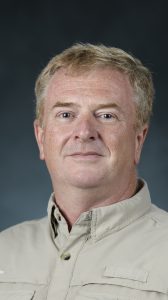
Arne R. Diercks is assistant marine research professor at the University of Southern Mississippi.Photo by Thomas Graning/Ole Miss Communications
OXFORD, Miss. – The slow and steady sedimentation processes of the deep sea is the next topic for a monthly public science forum organized by the University of Mississippi Department of Physics and Astronomy.
The fall semester’s second meeting of the Oxford Science Cafe is set for 6 p.m. Oct. 11 at Lusa Bakery Bistro and Bar, 1120 North Lamar Blvd. Arne R. Diercks, assistant research professor in the School of Ocean Science and Technology at the University of Southern Mississippi, will discuss “Perpetual Snow: Sedimentation in the Deep Sea.” Admission is free.
“Sedimentation in the deep ocean is a slow and steady supply of material to the deep sea via small particles,” Diercks said. “These individual particles are too small and light to overcome drag, currents and turbulence. However, once glued together by organic matrices into larger aggregates, these aggregates become a main source of energy, food and sediments in the deep sea and the seafloor.”
Diercks’ 30-minute presentation will include talk about how these aggregates, when illuminated by the lights of submersibles, take on the appearance of white spots in the darkness.
“They seemingly resemble slowly settling snowflakes,” he said. “Sedimentation rates in the deep ocean are small, ranging from a fraction to a few milliliters per year. Anthropogenic impacts can alter the sedimentation in even these remote areas.”
Spatial and temporal availability of the source material influences the distribution of these aggregates in the water column, affecting their size, densities and their residue times within the water column and their arrival at the ocean floor, he said. But even after arriving on the seafloor, their journey might not be over as turbulence can stir them back into the water as reshaped, broken up aggregates and particles.

Deep-sea sedimentation often appears like snowflakes descending to the ocean floor. Submitted photo
“For example, the Deepwater Horizon oil spill in the northern Gulf of Mexico resulted in the anthropogenic oil marine aggregates being deposited as an unprecedented large amount of material on the seafloor,” Diercks said.
Diercks’ research is made possible by a grant from the Gulf of Mexico Research Initiative to support the ECOGIC-2 research consortium.
UM administrators and professors said Diercks’ appearance should be most interesting.
“Dr. Diercks is one of the most prominent marine scientists in the U.S.,” said Marco Cavaglia, associate professor of physics and astronomy. “He has worked on marine snow aggregates specifically in the Gulf of Mexico, collecting size-specific settling speed and abundance data of aggregates using photographic techniques and sediment traps.
“His expertise in the mid-water sedimentation processes resulted in development of the first autonomous Neutrally Buoyant Sediment Trap system and then to his current work with AUVs.”
Diercks earned his doctorate in geological oceanography from USM, and master’s and bachelor’s degrees from the University of Hamburg in Germany. His research areas of expertise include marine snow aggregates and autonomous underwater vehicles, geographic information science, marine geology and geophysics and physical oceanography.
For more information about Oxford Science Cafe programs, go to http://www.phy.olemiss.edu/oxfordsciencecafe. For more information about the Department of Physics and Astronomy, visit http://www.olemiss.edu/depts/physics_and_astronomy or call 662-915-7046.